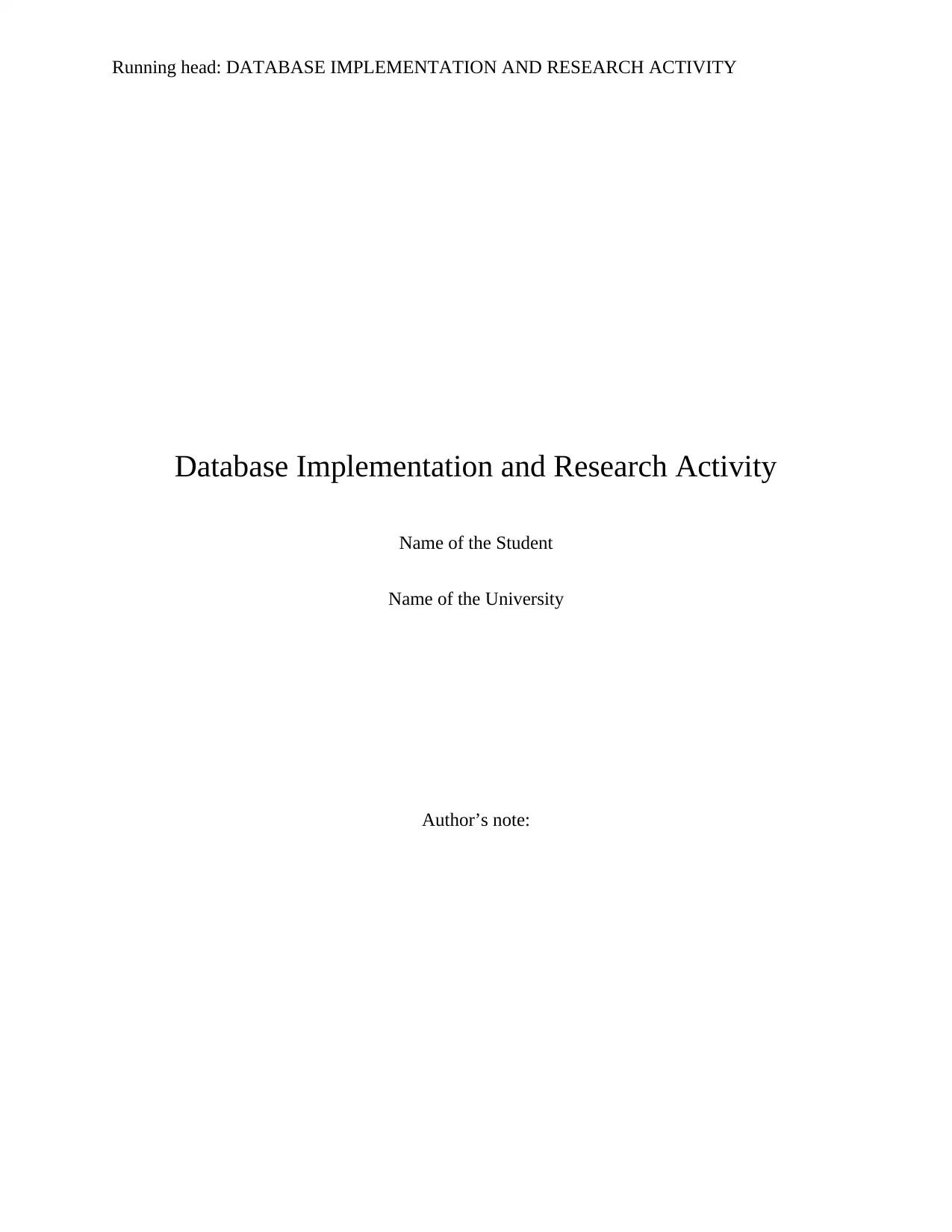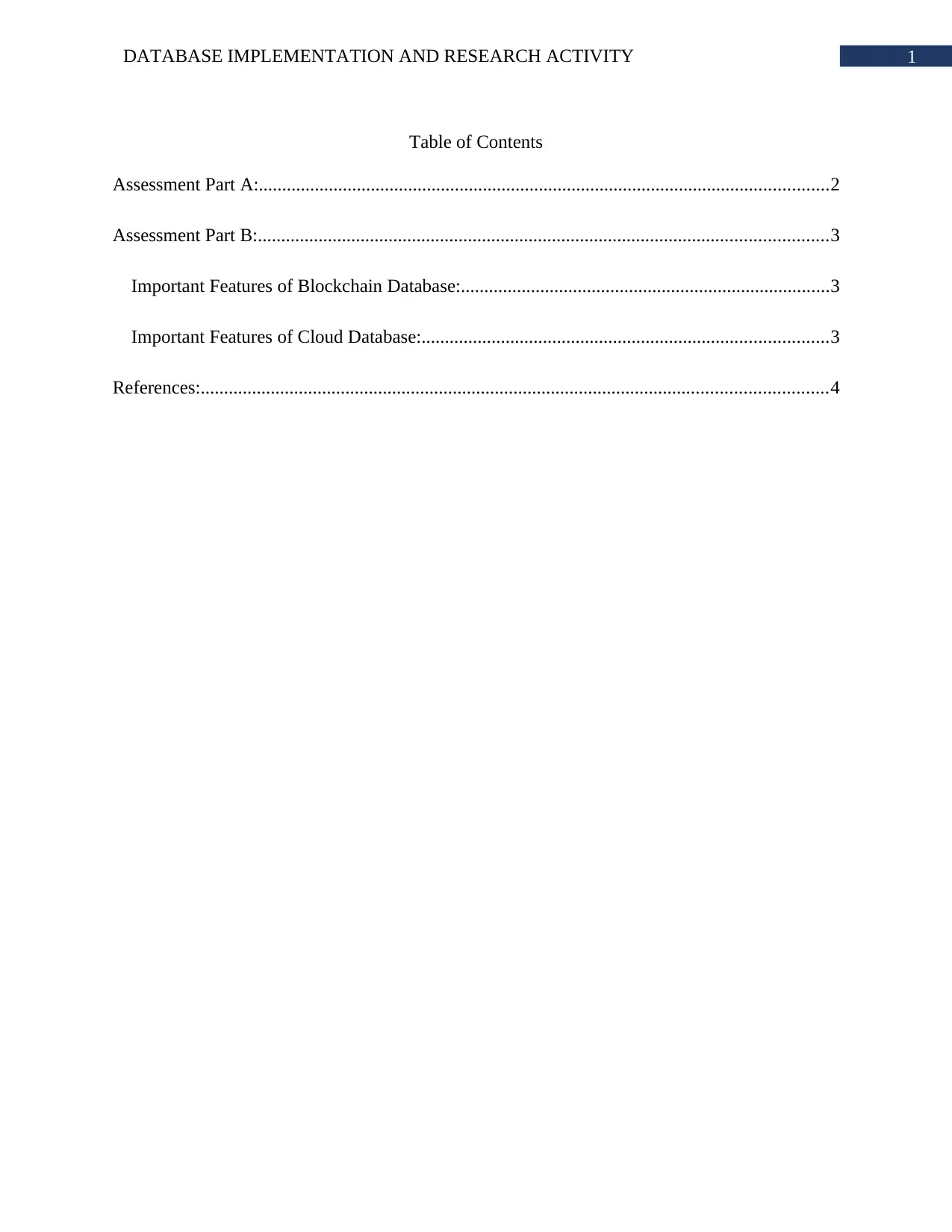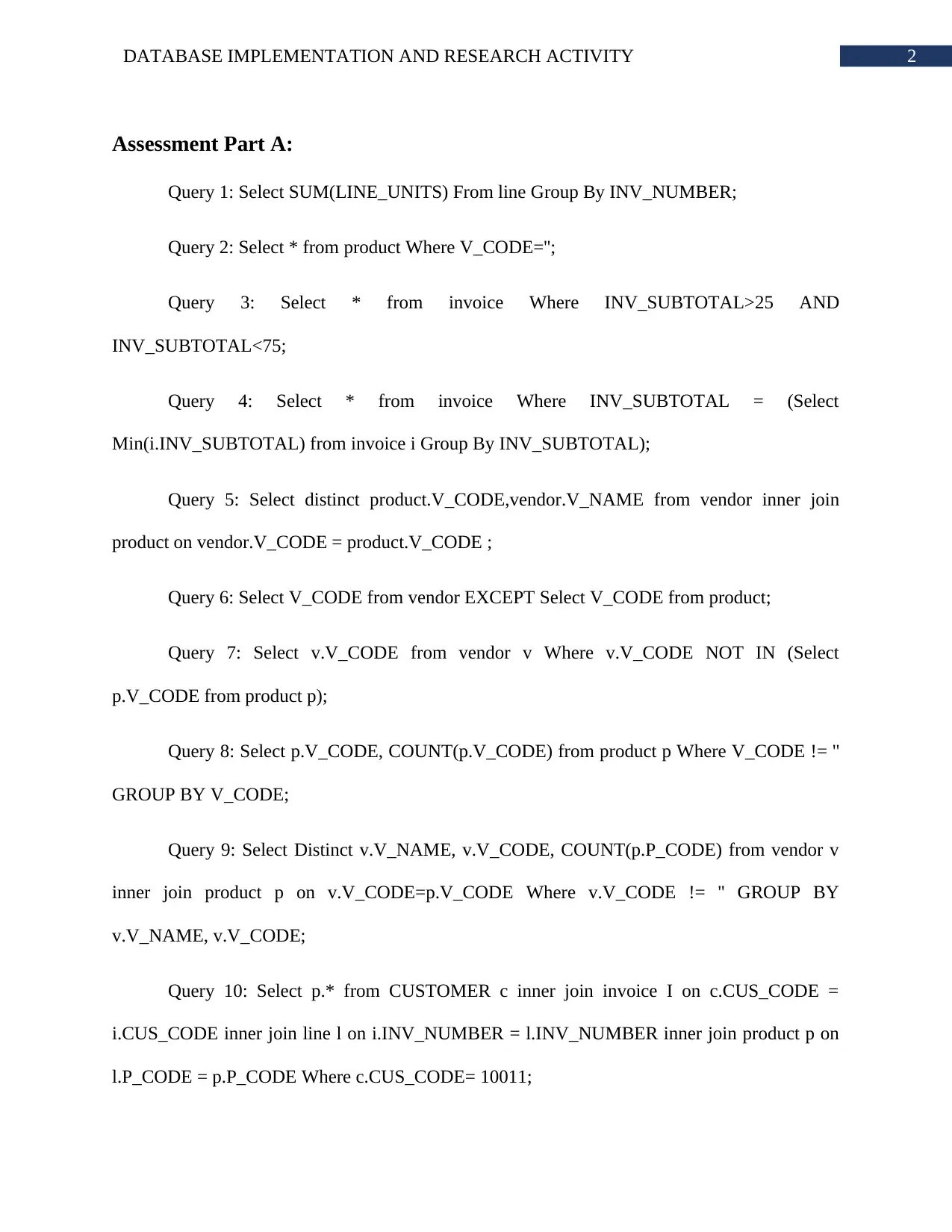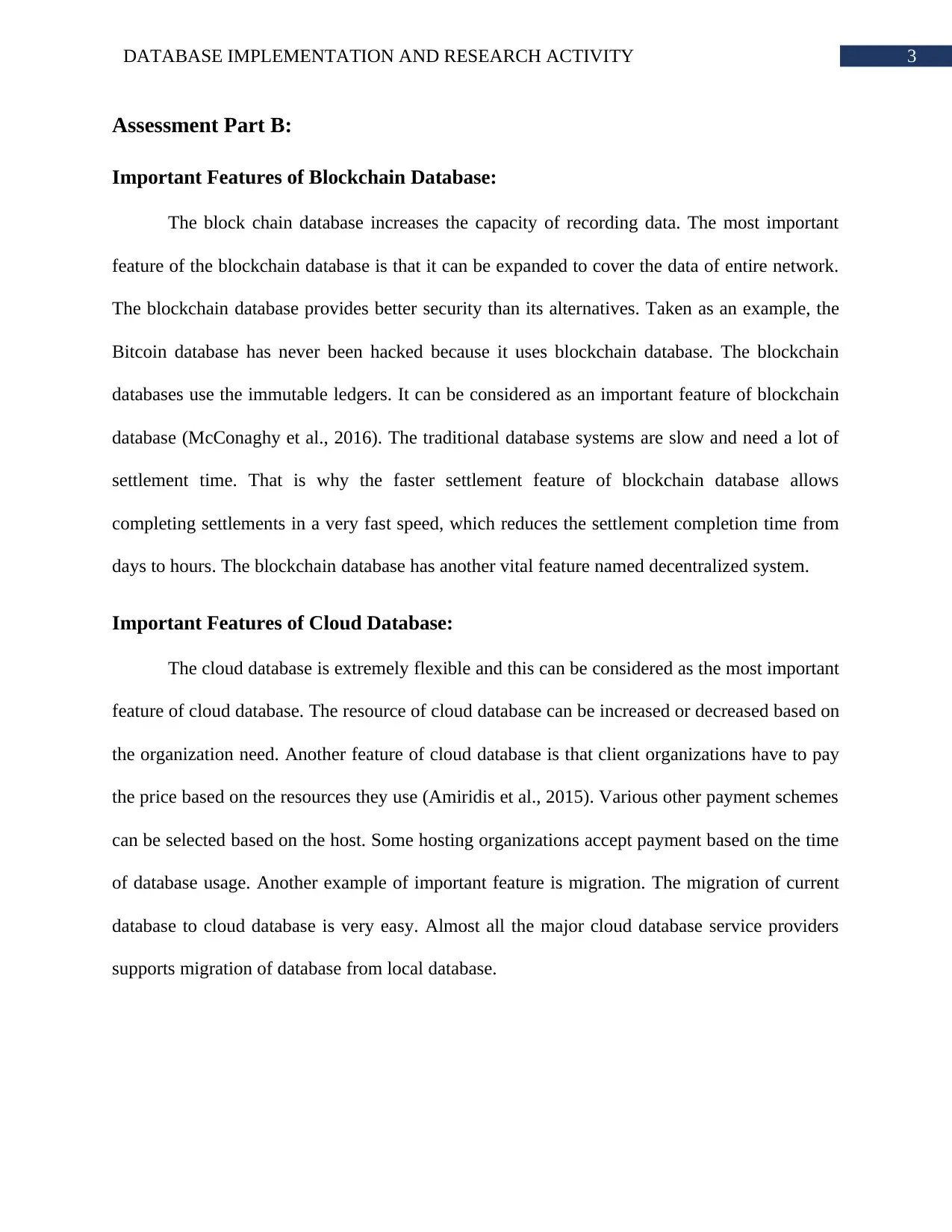SQL Queries and Database Implementation Research Activity - 2019
VerifiedAdded on 2023/04/24
|5
|676
|401
Homework Assignment
AI Summary
This assignment solution focuses on database implementation, encompassing both practical SQL query execution and research into different database types. The SQL queries address tasks such as calculating sums, filtering data based on conditions, finding minimum values, and joining tables to retrieve specific information. Additionally, the assignment delves into the important features of blockchain and cloud databases, highlighting aspects like data security, immutability, decentralization, flexibility, and scalability. The research component provides a comparative overview of these database technologies, emphasizing their respective strengths and use cases.

Running head: DATABASE IMPLEMENTATION AND RESEARCH ACTIVITY
Database Implementation and Research Activity
Name of the Student
Name of the University
Author’s note:
Database Implementation and Research Activity
Name of the Student
Name of the University
Author’s note:
Paraphrase This Document
Need a fresh take? Get an instant paraphrase of this document with our AI Paraphraser

1DATABASE IMPLEMENTATION AND RESEARCH ACTIVITY
Table of Contents
Assessment Part A:..........................................................................................................................2
Assessment Part B:..........................................................................................................................3
Important Features of Blockchain Database:...............................................................................3
Important Features of Cloud Database:.......................................................................................3
References:......................................................................................................................................4
Table of Contents
Assessment Part A:..........................................................................................................................2
Assessment Part B:..........................................................................................................................3
Important Features of Blockchain Database:...............................................................................3
Important Features of Cloud Database:.......................................................................................3
References:......................................................................................................................................4

2DATABASE IMPLEMENTATION AND RESEARCH ACTIVITY
Assessment Part A:
Query 1: Select SUM(LINE_UNITS) From line Group By INV_NUMBER;
Query 2: Select * from product Where V_CODE='';
Query 3: Select * from invoice Where INV_SUBTOTAL>25 AND
INV_SUBTOTAL<75;
Query 4: Select * from invoice Where INV_SUBTOTAL = (Select
Min(i.INV_SUBTOTAL) from invoice i Group By INV_SUBTOTAL);
Query 5: Select distinct product.V_CODE,vendor.V_NAME from vendor inner join
product on vendor.V_CODE = product.V_CODE ;
Query 6: Select V_CODE from vendor EXCEPT Select V_CODE from product;
Query 7: Select v.V_CODE from vendor v Where v.V_CODE NOT IN (Select
p.V_CODE from product p);
Query 8: Select p.V_CODE, COUNT(p.V_CODE) from product p Where V_CODE != ''
GROUP BY V_CODE;
Query 9: Select Distinct v.V_NAME, v.V_CODE, COUNT(p.P_CODE) from vendor v
inner join product p on v.V_CODE=p.V_CODE Where v.V_CODE != '' GROUP BY
v.V_NAME, v.V_CODE;
Query 10: Select p.* from CUSTOMER c inner join invoice I on c.CUS_CODE =
i.CUS_CODE inner join line l on i.INV_NUMBER = l.INV_NUMBER inner join product p on
l.P_CODE = p.P_CODE Where c.CUS_CODE= 10011;
Assessment Part A:
Query 1: Select SUM(LINE_UNITS) From line Group By INV_NUMBER;
Query 2: Select * from product Where V_CODE='';
Query 3: Select * from invoice Where INV_SUBTOTAL>25 AND
INV_SUBTOTAL<75;
Query 4: Select * from invoice Where INV_SUBTOTAL = (Select
Min(i.INV_SUBTOTAL) from invoice i Group By INV_SUBTOTAL);
Query 5: Select distinct product.V_CODE,vendor.V_NAME from vendor inner join
product on vendor.V_CODE = product.V_CODE ;
Query 6: Select V_CODE from vendor EXCEPT Select V_CODE from product;
Query 7: Select v.V_CODE from vendor v Where v.V_CODE NOT IN (Select
p.V_CODE from product p);
Query 8: Select p.V_CODE, COUNT(p.V_CODE) from product p Where V_CODE != ''
GROUP BY V_CODE;
Query 9: Select Distinct v.V_NAME, v.V_CODE, COUNT(p.P_CODE) from vendor v
inner join product p on v.V_CODE=p.V_CODE Where v.V_CODE != '' GROUP BY
v.V_NAME, v.V_CODE;
Query 10: Select p.* from CUSTOMER c inner join invoice I on c.CUS_CODE =
i.CUS_CODE inner join line l on i.INV_NUMBER = l.INV_NUMBER inner join product p on
l.P_CODE = p.P_CODE Where c.CUS_CODE= 10011;
⊘ This is a preview!⊘
Do you want full access?
Subscribe today to unlock all pages.

Trusted by 1+ million students worldwide

3DATABASE IMPLEMENTATION AND RESEARCH ACTIVITY
Assessment Part B:
Important Features of Blockchain Database:
The block chain database increases the capacity of recording data. The most important
feature of the blockchain database is that it can be expanded to cover the data of entire network.
The blockchain database provides better security than its alternatives. Taken as an example, the
Bitcoin database has never been hacked because it uses blockchain database. The blockchain
databases use the immutable ledgers. It can be considered as an important feature of blockchain
database (McConaghy et al., 2016). The traditional database systems are slow and need a lot of
settlement time. That is why the faster settlement feature of blockchain database allows
completing settlements in a very fast speed, which reduces the settlement completion time from
days to hours. The blockchain database has another vital feature named decentralized system.
Important Features of Cloud Database:
The cloud database is extremely flexible and this can be considered as the most important
feature of cloud database. The resource of cloud database can be increased or decreased based on
the organization need. Another feature of cloud database is that client organizations have to pay
the price based on the resources they use (Amiridis et al., 2015). Various other payment schemes
can be selected based on the host. Some hosting organizations accept payment based on the time
of database usage. Another example of important feature is migration. The migration of current
database to cloud database is very easy. Almost all the major cloud database service providers
supports migration of database from local database.
Assessment Part B:
Important Features of Blockchain Database:
The block chain database increases the capacity of recording data. The most important
feature of the blockchain database is that it can be expanded to cover the data of entire network.
The blockchain database provides better security than its alternatives. Taken as an example, the
Bitcoin database has never been hacked because it uses blockchain database. The blockchain
databases use the immutable ledgers. It can be considered as an important feature of blockchain
database (McConaghy et al., 2016). The traditional database systems are slow and need a lot of
settlement time. That is why the faster settlement feature of blockchain database allows
completing settlements in a very fast speed, which reduces the settlement completion time from
days to hours. The blockchain database has another vital feature named decentralized system.
Important Features of Cloud Database:
The cloud database is extremely flexible and this can be considered as the most important
feature of cloud database. The resource of cloud database can be increased or decreased based on
the organization need. Another feature of cloud database is that client organizations have to pay
the price based on the resources they use (Amiridis et al., 2015). Various other payment schemes
can be selected based on the host. Some hosting organizations accept payment based on the time
of database usage. Another example of important feature is migration. The migration of current
database to cloud database is very easy. Almost all the major cloud database service providers
supports migration of database from local database.
Paraphrase This Document
Need a fresh take? Get an instant paraphrase of this document with our AI Paraphraser

4DATABASE IMPLEMENTATION AND RESEARCH ACTIVITY
References:
Amiridis, V., Marinou, E., Tsekeri, A., Wandinger, U., Schwarz, A., Giannakaki, E., ... &
Herekakis, T. (2015). LIVAS: a 3-D multi-wavelength aerosol/cloud database based on
CALIPSO and EARLINET.
McConaghy, T., Marques, R., Müller, A., De Jonghe, D., McConaghy, T., McMullen, G., ... &
Granzotto, A. (2016). BigchainDB: a scalable blockchain database. white paper,
BigChainDB.
References:
Amiridis, V., Marinou, E., Tsekeri, A., Wandinger, U., Schwarz, A., Giannakaki, E., ... &
Herekakis, T. (2015). LIVAS: a 3-D multi-wavelength aerosol/cloud database based on
CALIPSO and EARLINET.
McConaghy, T., Marques, R., Müller, A., De Jonghe, D., McConaghy, T., McMullen, G., ... &
Granzotto, A. (2016). BigchainDB: a scalable blockchain database. white paper,
BigChainDB.
1 out of 5
Related Documents
Your All-in-One AI-Powered Toolkit for Academic Success.
+13062052269
info@desklib.com
Available 24*7 on WhatsApp / Email
![[object Object]](/_next/static/media/star-bottom.7253800d.svg)
Unlock your academic potential
Copyright © 2020–2025 A2Z Services. All Rights Reserved. Developed and managed by ZUCOL.





